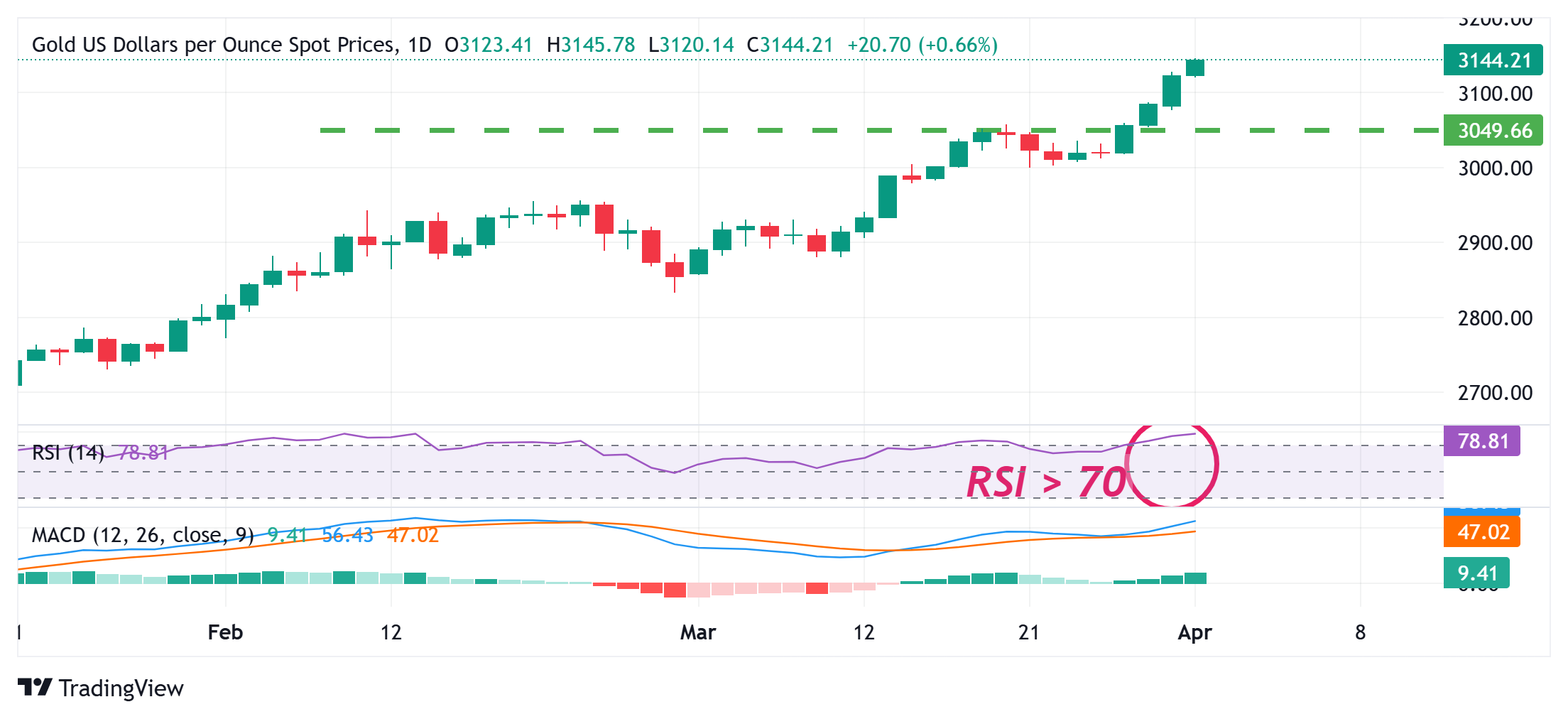- Gold price continues to scale new record highs for the fourth straight day on Tuesday.
- Worries about the widening global trade war and geopolitical risks boost the commodity.
- Fed rate cut bets weigh on the USD and further benefit the non-yielding yellow metal.
Gold price (XAU/USD) builds on the previous day’s breakout momentum beyond the $3,100 mark and gains positive traction for the fourth successive day on Tuesday. The momentum lifts the commodity to a fresh all-time peak, around the $3,144-3,145 area during the Asian session, and is sponsored by the global flight to safety. Investors remain worried about the potential economic fallout from US President Donald Trump’s aggressive trade policies. Adding to this, geopolitical tensions turn out to be key factors that continue to boost demand for the traditional safe-haven bullion.
Meanwhile, investors now seem convinced that a tariff-driven slowdown in US economic growth will outweigh a temporary lift in inflation and prompt the Federal Reserve (Fed) to resume its rate-cutting cycle soon. This keeps the US Dollar (USD) bulls on the defensive and lends additional support to the non-yielding Gold price. The XAU/USD bulls seem rather unaffected by an improvement in the global risk sentiment. However, overbought conditions warrant some caution before placing fresh bullish bets around the XAU/USD pair and positioning for any further appreciating move.
Daily Digest Market Movers: Gold price continues to attract safe-haven flows amid rising trade tensions
- The US President dashed hopes the levies would be limited to a smaller group of countries with the biggest trade imbalances and said on Sunday that reciprocal tariffs would essentially include all nations. This comes on top of Trump’s 25% tariff on steel and aluminum, and auto imports, stoking worries about a widening global trade war.
- Furthermore, investors now seem convinced that a tariff-driven slowdown in the US economic activity would force the Federal Reserve (Fed) to resume its rate-cutting cycle soon, despite sticky inflation. This, in turn, assists the safe-haven Gold price to register its strongest quarter since 1986 and hit a fresh record high on Tuesday.
- The markets are currently pricing in the possibility that the US central bank will lower borrowing costs by 80 basis points by the end of this year. This keeps the US Treasury bond yields depressed, which, in turn, does little to help the US Dollar attract any meaningful buyers and further underpins the non-yielding yellow metal.
- On the geopolitical front, Ukrainian officials said early on Monday that Russia bombed the city of Kharkiv in north-eastern Ukraine for the second night in a row. Moreover, Ukraine’s President, Volodymyr Zelenskyy said that Russia had fired more than 1,000 drones in the past week and called for a response from the US and other allies.
- Israel earlier this month ended its ceasefire with the Hamas militant group and renewed its air and ground strikes. Adding to this, the Israeli military has issued mass evacuation orders for Rafah, signaling a possible new ground operation in the city, raising the risk of a further escalation of tensions in the region.
- Traders now look to this week’s key US macro releases, scheduled at the beginning of a new month, starting with the JOLTS openings and ISM Manufacturing PMI on Tuesday. This will be followed by the ADP report on Wednesday, US ISM Services PMI on Thursday, and the closely-watched US Nonfarm Payrolls (NFP) on Friday.
- The focus, however, will remain glued to Trump’s impending reciprocal tariffs announcement later today, at 19:00 GMT. This will play a key role in influencing the broader risk sentiment and the USD price dynamics, which, in turn, should provide some meaningful impetus to the XAU/USD pair.
Gold price could witness a corrective pullback amid overbought daily RSI; bullish potential seems intact

From a technical perspective, the daily Relative Strength Index (RSI) stands well above the 70 mark and indicates overbought conditions. This, in turn, makes it prudent to wait for some near-term consolidation or a modest pullback before traders start positioning for any further appreciating move. Nevertheless, the overnight breakout above the $3,100 mark and the subsequent move up suggest that the path of least resistance for the Gold price remains to the upside. Hence, any corrective pullback could be seen as a buying opportunity and is more likely to remain limited.
In the meantime, the $3,128-3,127 region could act as immediate support ahead of the $3,100 round figure. A convincing break below the latter might prompt some long-unwinding and drag the Gold price below the $3,076 area, or the overnight swing low, towards the $3,057-3,058 resistance breakpoint en route to the $3,036-3,035 support zone. This is followed by the $3,000 psychological mark, which should act as a strong base for the XAU/USD and key pivotal point for short-term traders.
Tariffs FAQs
Tariffs are customs duties levied on certain merchandise imports or a category of products. Tariffs are designed to help local producers and manufacturers be more competitive in the market by providing a price advantage over similar goods that can be imported. Tariffs are widely used as tools of protectionism, along with trade barriers and import quotas.
Although tariffs and taxes both generate government revenue to fund public goods and services, they have several distinctions. Tariffs are prepaid at the port of entry, while taxes are paid at the time of purchase. Taxes are imposed on individual taxpayers and businesses, while tariffs are paid by importers.
There are two schools of thought among economists regarding the usage of tariffs. While some argue that tariffs are necessary to protect domestic industries and address trade imbalances, others see them as a harmful tool that could potentially drive prices higher over the long term and lead to a damaging trade war by encouraging tit-for-tat tariffs.
During the run-up to the presidential election in November 2024, Donald Trump made it clear that he intends to use tariffs to support the US economy and American producers. In 2024, Mexico, China and Canada accounted for 42% of total US imports. In this period, Mexico stood out as the top exporter with $466.6 billion, according to the US Census Bureau. Hence, Trump wants to focus on these three nations when imposing tariffs. He also plans to use the revenue generated through tariffs to lower personal income taxes.

